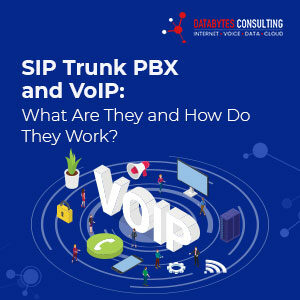
When deciding between Hosted PBX and SIP trunk PBX, you first need to analyze your communication needs. The common rule of thumb is to purchase one SIP channel for every three users, but you may want to upgrade your SIP channel count if you experience wait time complaints. In addition to VoIP phones, many businesses also retain landlines for compatibility reasons.
SIP trunking relies on servers to transmit voice traffic. Choose a telecommunications service provider such as Databytes Consulting that has the redundant infrastructure to ensure maximum reliability. Moreover, look for a provider that charges less than traditional phone service. While comparing SIP trunking plans, consider the price of the service. You can save up to 50 percent on your monthly bill with a good provider. And remember, those SIP trunks are not as flexible as regular phone service.
Using the SIP protocol, you can connect SIP trunks to your PBX server and end phone numbers. SIP trunks can reduce the cost of long-distance by providing cheaper access to international destinations and enabling you to terminate phone numbers on your PBX server. They also make customer contact and sales much easier. Another advantage of SIP trunks is that they are not tied to a specific location. Unlike conventional phone lines, you don’t have to change stationary or forward calls.
If you are looking for a flexible and reliable phone system that can scale with your business needs, you should consider using a hosted PBX for SIP trunk and VoIP. The advantages of hosted PBX are numerous, including call encryption, redundant carriers, and flexibility. In addition, you can choose from a variety of plans to suit your business’s specific needs. Whether you are looking to use one or both systems, the following information can help you make the right choice.
A hosted PBX for SIP trunk and VoIP service provider will provide you with a dedicated connection for telephony. The benefits of SIP trunking are obvious: they provide commercial-grade communication. However, poor call quality can completely negatively affect the benefits of this type of service. Look for a company that offers redundant infrastructure and competitive pricing. You can expect a lower cost than you would pay for traditional phone service.
SIP Trunking is a secure premise-based phone system that prioritizes call quality. Its advantages include security and more control. As SIP trunks send calls over a data network, available bandwidth plays a significant role in voice quality. The bandwidth required depends on the voice codec used and the available internet connection. For example, G.711 voice codec can consume 85kbps per call, making it possible to support up to six simultaneous calls on a 512kbps DSL connection. Broadband connections, on the other hand, use far more bandwidth.
SIP trunking allows your business to communicate with people across the globe. In addition, this system allows remote employees to maintain seamless communication channels with their managers and colleagues.
If you have remote workers joining your business from other parts of the globe, SIP trunking can be a great option. SIP can help to solve issues such as scalability. Changes in employees won’t cause system failures.
The cost of SIP trunks can vary significantly, depending on the number of lines and the vendor you choose. Monthly rates can range from $20 to $70 per line, excluding the upfront cost of the SIP setup. In addition, many business-class SIP vendors charge a one-time set-up fee, while others may include it in the monthly price. These fees typically cover consultation, implementation, and quality testing, ranging from $50 to $250.
SIP trunking plans vary greatly, and you will need to determine which plan best meets your needs and budget. Some providers charge a flat rate for a specific number of users, while others charge per line, which can range from $10 to $50 per month. SIP trunking plans can be as low as $1 per line, while others charge $10 to $50 per line. If you’re looking for a low-cost solution, you can opt for a free trial from a reputable provider.
In conclusion
You can see that combining SIP trunking, VoIP, and PBX offers many communication benefits. However, with more companies opening up every day, it is important to make sure your business stays competitive.
This is true. However, not all service providers offer the same three. This can lead to integration problems. It will pay off in the long-term and be a benefit to your business to find an IT services company that offers all three.
At Databytes Consulting, we provide your organization with the required VoIP and SIP trunk PBX systems. Experience quality services with infrastructure from top providers and unparalleled customer service.
Contact us